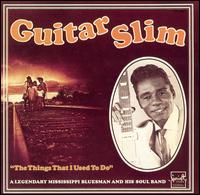| "The Things That I Used to Do" | ||||
|---|---|---|---|---|
 | ||||
| Single by Guitar Slim | ||||
| B-side | "Well, I Done Got Over It" | |||
| Released | 1953 | |||
| Recorded | 1953 | |||
| Studio | J&M (New Orleans, Louisiana) | |||
| Genre | ||||
| Length | 2:57 | |||
| Label | Specialty | |||
| Songwriter(s) | Eddie Jones a.k.a. Guitar Slim | |||
| Producer(s) | Ray Charles | |||
| Guitar Slim singles chronology | ||||
| ||||
| Audio sample | ||||
"The Things That I Used to Do" is a blues standard written by Guitar Slim. He recorded it at Cosimo Matassa's J&M Recording Studio in New Orleans, where the young Ray Charles arranged and produced the session. [1] Specialty Records released the song as a single in 1953 and it became a bestseller the following year. Specialty founder Art Rupe believed that the appeal would be limited to the Southern U.S. rural audience. However, urban rhythm and blues radio stations in the North began airing the song and built it into a national hit. As a result, Guitar Slim became in great demand as a performer and played at venues such as the Apollo Theater in New York City.
Contents
The single was one of the biggest hits in Specialty's history and stayed on the Billboard's Rhythm and Blues Records charts for 42 weeks. The song remained at number one for six weeks and was the best-selling R&B record of the year, selling more than a million copies. [2]